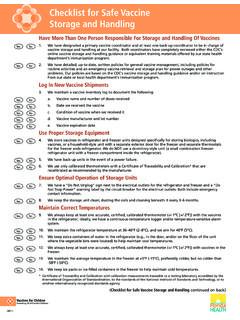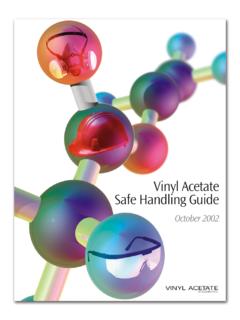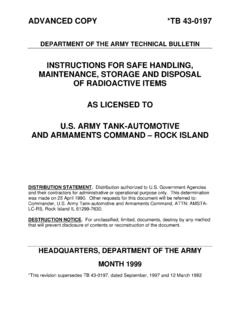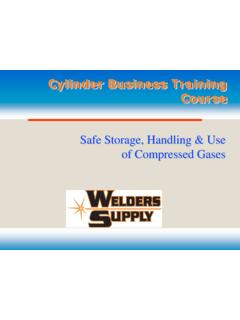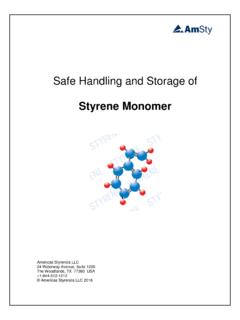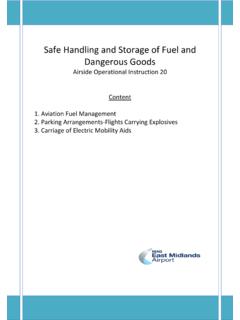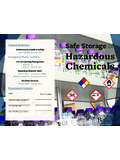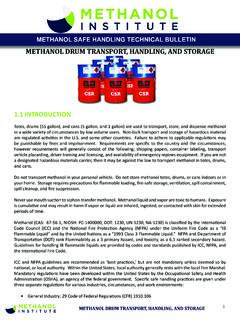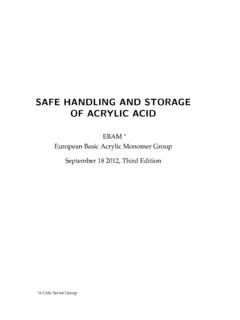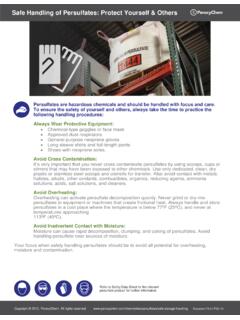Transcription of Methyl Chloride: Handling, Storage and Safety
1 Product Information Page 1 of 12 Trademark of Olin Corporation or an affiliated company of Olin Form No. 103-00138-1215 Methyl chloride : handling , Storage and Safety Please use this guide in conjunction with this product s country-specific Safety Data Sheet (SDS) and the safe Use conditions as described therein. Current Safety Data Sheets can be requested from Olin at Background Methyl chloride is a clear, colorless gas. It has a faint, sweet odor that is noticeable only at levels that may be toxic. It is heavier than air and extremely flammable. It is stored and shipped under pressure. Nearly all of the Methyl chloride produced is used as a raw material in the manufacture of other chemicals, including chloromethanes, silicone fluids and polymers, Methyl cellulose, quaternary ammonium compounds, agricultural products, and butyl rubber.
2 Olin ships Methyl chloride in dedicated tank cars, tank trucks, and isocontainers. Toxicity and safe handling Please refer to the current Safety Data Sheet (SDS) prior to working with Methyl chloride . Because Methyl chloride is a colorless gas at room temperature with a mild odor only at toxic concentrations, it may pose a significant hazard to human health. Although liquid Methyl chloride may produce frostbite-type burns upon skin contact, inhalation is the principal hazard. Initial symptoms of excessive inhalation exposure include lack of coordination and impaired judgment. High exposures may lead to uncoordinated movements, weakness, tremors, speech difficulties, and blurred vision. Gastrointestinal upset may occur with severe acute poisoning.
3 Extreme exposures may cause convulsions, coma, or death. Any person showing or feeling the effects of inhaling Methyl chloride should be removed to fresh air immediately and given prompt medical attention. A physician should be called or the person transported to a medical facility. If breathing stops, remove to fresh air, artificial respiration should be given, and oxygen should be administered by qualified personnel. Long-term exposure has been noted to cause kidney, liver, spleen, and testes effects in animals, and nervous system effects in humans. Repeated significant exposure to Methyl chloride was also found to cause birth defects in animals and has been shown in animal studies to interfere with fertility in males. To minimize exposure to Methyl chloride , adequate ventilation should be provided in the workplace.
4 Exposure levels of Methyl chloride vapor in the workplace atmosphere must be maintained below established occupational exposure limits (OEL). OEL s may vary by jurisdiction. Page 2 of 12 Trademark of Olin Corporation or an affiliated company of Olin Form No. 103-0131-1215 Exposure List3 Type Exposure Limit Dow Industrial Hygiene Guideline TWA 25ppm Dow Industrial Hygiene Guideline STEL 50ppm ACGIH TWA 50ppm ACGIH STEL 100ppm US OSHA/Z2 TWA 100ppm US OSHA/Z2 Ceiling 200ppm US OSHA/Z2 Maximum Concentration 300ppm (5 min in any 3 hours) The potential for dermal absorption of Methyl chloride exists, including the mucous membranes and the eyes, either by contact with vapors or by direct skin contact. 1 Industrial Hygiene Guides (IHG) are Dow's internally-set occupational exposure guidelines (OEGs or aka: OELs).
5 They are similar exposure guidelines set forth by regulatory bodies, but Dow s IHG s are not regulatory in nature. Olin Blue Cube Operations LLC currently follows Dow s Industrial Hygiene Guideline. 2 Occupational Safety and Hygiene Administration is a US federal agency that regulates the Safety and health of workers in the USA; "Z2" regulates exposures to chemicals or hazardous substances in the workplace. 3 These are example exposure limits. Please refer to your SDS for specific occupational exposure limits, as exposure limits and relevant regulations may differ from the values listed depending on the jurisdiction. Because of the lack of warning properties at levels approaching the exposure guidelines, it is recommended that a suitable method of continuous sampling and analysis of the work area be employed to ensure that the exposure guidelines are not exceeded.
6 Monitoring of the work area air for Methyl chloride contamination may be accomplished by suitable commercially available detection devices. Personal Protection Workers should be thoroughly trained regarding the hazards of Methyl chloride before starting any work involving this chemical. Persons working with Methyl chloride should be provided with and instructed in the use of appropriate personal protective clothing and equipment, as required. Ventilation should be provided to control and maintain vapor concentrations below currently accepted OEL(s). In areas of insufficient ventilation or during emergency situations, self-contained, positive-pressure breathing apparatus approved by the National Institute of Occupational Safety and Health (NIOSH; provides technical research and guidance to the OSHA) should be used.
7 Cartridge or canister type respirators are not recommended for use with Methyl chloride . The workplace should be equipped with readily accessible eye wash fountains and deluge-type Safety showers in the event of accidental eye or skin contact. If hand protection is needed, use an insulated glove for protection from liquid contact of the skin that may cause frostbite due to rapid cooling. When the potential for skin contact with liquid Methyl chloride is a possibility, use of chemical protective gloves along with thermal gloves should be considered. Examples of preferred glove barrier materials include: Viton , polyvinyl alcohol ("PVA") or ethyl vinyl alcohol laminate ("EVAL"). Examples of acceptable glove barrier materials include: Butyl rubber, Neoprene, and Nitrile/butadiene rubber ("nitrile" or "NBR").
8 Avoid gloves made of: Polyvinyl chloride ("PVC" or "vinyl"). Note: the selection of a specific glove for a particular application and duration of use in a workplace should also take into account all relevant workplace factors such as, but not limited to: other chemicals which may be handled, physical requirements (cut / puncture protection, dexterity, thermal protection), potential body reactions to glove materials, as well as the instructions / specifications provided by the glove supplier. Page 3 of 12 Trademark of Olin Corporation or an affiliated company of Olin Form No. 103-0131-1215 Product Storage Each Methyl chloride user is responsible for design and implementation of a Storage and handling system that is suitable for their individual facility.
9 Experience has shown that overexposure to Methyl chloride is most likely to arise during Storage , filling of transport equipment, handling and maintenance operations. Please read this section carefully. Bulk Storage Carbon-steel pressure tanks, designed according to the ASME Code for Unfired Pressure Vessels, are suitable for the bulk Storage of Methyl chloride . The Storage tank should be designed for a minimum working pressure of 160 psig and equipped with a pressure-indicating device and dual Safety valves set at the maximum allowable working pressure of the vessel. All piping should be Schedule 80, standard carbon steel that is welded throughout to eliminate screwed fittings. Differential pressure devices are suggested for level measurements.
10 Tanks should be located above ground in a limited access area away from buildings, thoroughfares, etc. Tanks should be equipped with a sprinkler, deluge monitor, or other fire suppression system. Spill containment for both the Storage and unloading area should be designed to prevent spilled material from collecting under tanks, tank cars, or process lines. All electrical wiring, fixtures, and equipment should be installed in accordance with the applicable national or local electrical standards, such as the National Electric Code for Class 1, Group D, Division 2 Hazardous Locations. Grounding of the Methyl chloride system should be carefully planned and implemented to assure proper protection. The Importance of Labeling All transfer lines, piping and receiving containers should be properly labeled.
